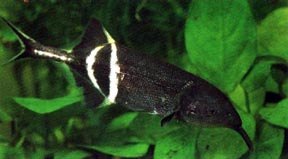Individual Fish Description Page


This page will give a completely detailed profile of the
selected fish, from A to Z. The profiled fish will be
chosen randomly by Badman, and will come from the complete
genre of tropical fish. I will try to up-date the profile
on a monthly basis. If you have a specific fish you want
profiled please vote for it in the favorite fish poll on the main index page.


Photo from "Aquarium Fish".
GNATHONEMUS PETERSI
Overview:
The unusual appearance and novelty of the Elephant Nose has increased its popularity in recent years. If the proper care is taken they will be a rewarding member of your fish community .
Quick stats:
| size: | Up to nine inches
|
| tank: | 40 inches |
| strata: | Bottom, middle |
| pH: | 6.0 to 7.5 |
| Hardness: | soft to hard |
| temperature: | 73o to 84o f |
Classification:
| Order: | Mormyriformes |
| Family: | Mormyridae |
| Genera: | Gnathonemus |
Common name:
Elephant Nose, Peters Elephantnose
Distribution:
Central Africa, in the Zaire river basin, from the Niger to the Cameroons.
General Body Form:
There is no other fish that even closely resembles the Elephant nose. The top and bottom profiles are almost identical, which come to an end in a forked shaped caudal fin (Tail.) The small Dorsal fin is located at the end of the body, it to is mirrored by the anal fin. The most distinguishing trait of the fish is its' mouth. It is located at the eye level and the lower jaw section extends into a moveable trunk like extension. Guess where the common name comes from.
Coloration:
Overall the color of the fish is a dark Brown or Black color. There are a pair of somewhat yellow vertical bands that extend from the back of the dorsal to the Anal fin. Not a stunning fish as far as color goes, but nice in its own right.
Maintenance:
The Elephant Nose are shy by nature and will require a well planted aquarium, with subdued lighting and a soft substrate. You must include hiding places in the form of clay pipes, rockwork or driftwood. They should be kept singly as they are somewhat aggressive to their own species. Nocturnal in nature they will become more active at dusk and start looking for food, it is important to provide this to them after the lights come out. Given time they will become active with the other fish with the lights on. Feed them with Tubifex worms, Mosquito larva and Bloodworms. They are a member of the electric fish family and emit a small electrical charges that change with their mood. They are very sensitive to water quality and I have read that some municipal water companies use them as a gauge of water purity.
Biotope:
Slow moving water, with submerged wood and plants.
Breeding:
Sexual differances and breeding are unknown at this time, but it is said that they construct floating nest that slowly float with the water and the frys' first food develop in the nest as well.



back to the fish profile page.

Email:
badman2nd@hotmail.com





